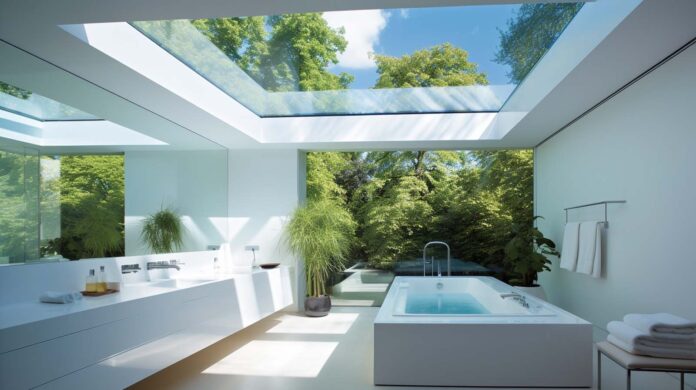Skylights offer a unique way to invite in more natural light. Natural light isn’t just a pleasing aesthetic feature in our homes; it plays a crucial role in our overall well-being. The gentle warmth of sunlight streaming through a window, the way it can transform a space, and how it affects our mood are testaments to the power of nature’s illumination. When we harness the sun’s light in our homes, we invite in a host of potential health benefits that can enhance our everyday lives.
Beyond their aesthetic appeal, skylights can also boost our health in numerous ways. This article will delve into these benefits, demonstrating why skylights are a valuable addition to your home.
The Power of Natural Light
The Incredible Benefits of Exposure to Natural Light
There’s something quite special about natural light and the way it influences our overall health and well-being. Exposure to natural light plays a critical role in our lives, affecting various aspects of our physical and mental health. The warm embrace of sunlight enhances our mood, stimulating the production of serotonin, often referred to as the ‘feel-good’ hormone. Natural light also facilitates our body’s production of vitamin D, a nutrient essential for bone health, immune function, and inflammation reduction. Moreover, it aids in regulating our internal body clock or circadian rhythm, promoting better sleep patterns and consequently increasing our productivity, as well as boosting our mental acuity and concentration levels.
Skylights: A Gateway to Increasing Natural Light in the Home
In the context of home design and architecture, skylights emerge as an effective solution to amplify the penetration of natural light into our homes. Thoughtfully positioned, these windows to the sky can revolutionize the way light enters and interacts with your interior spaces. They have the unique ability to illuminate darker corners, balance light distribution across larger spaces, and infuse life into rooms that may otherwise seem dull or dimly lit. From a health perspective, this increased exposure to natural light only amplifies the benefits mentioned earlier. With skylights, we have the opportunity to capture more daylight, extending its presence in our homes, and thereby enhancing our access to its numerous health benefits. The result is a living space that not only looks inviting but also contributes positively to our well-being.
Physical Health Benefits of Skylights
Natural Light and the Regulation of Sleep-Wake Cycles
One significant aspect of physical health influenced by natural light exposure is the regulation of our sleep-wake cycles, also known as circadian rhythms. Exposure to natural light during the daytime stimulates the production of serotonin, a hormone responsible for boosting mood and creating a feeling of calm and focus. As the day progresses into night, our body transforms some of this serotonin into melatonin, the hormone responsible for inducing sleep. Thus, regular exposure to daylight through skylights can help regulate our circadian rhythms, promoting healthier and more consistent sleep patterns, which ultimately results in enhanced overall well-being and increased productivity.
The Contribution of Natural Light to Vitamin D Synthesis
Vitamin D synthesis in our bodies is another health aspect significantly influenced by exposure to sunlight. This vitamin plays an essential role in calcium absorption for bone health, boosts immune function, and reduces inflammation. Deficiency in Vitamin D can lead to a range of health problems, including fatigue, depression, and bone pain. Incorporating skylights into your home design can help increase your exposure to sunlight, encouraging your body’s synthesis of this critical vitamin and contributing to your overall physical health.
The Positive Effects of Skylights on Eye Health
Skylights can also have profound effects on eye health. Constant exposure to artificial light can lead to digital eye strain or computer vision syndrome. These ailments result in symptoms such as dry and irritated eyes, blurred vision, and headaches. Natural light, on the other hand, is softer and more varied, reducing the strain on our eyes. Skylights, providing a steady source of natural light, can help alleviate these symptoms and contribute to overall eye health, especially in spaces where you spend significant time working or reading.
Mental Health Benefits of Skylights
Skylights and Mood Enhancement
Skylights can significantly influence our mood and overall mental well-being. Natural light exposure stimulates serotonin production, often referred to as the “happy hormone” due to its mood-enhancing effects. A well-lit room with natural light streaming through skylights creates a more cheerful, positive environment, which can help elevate mood and counter feelings of anxiety or depression. Moreover, the dynamic nature of natural light, changing throughout the day, can create a sense of connection with the outside world and the passage of time, enhancing mental well-being.
Combatting Seasonal Affective Disorder (SAD) with Skylights
For those who suffer from Seasonal Affective Disorder (SAD) – a type of depression that typically occurs during the fall and winter months when daylight hours are shorter – skylights can provide much-needed exposure to natural light. Research shows that bright light therapy, involving exposure to bright, natural light, can effectively alleviate SAD symptoms. Skylights can provide a natural source of this beneficial light, helping to mitigate the effects of SAD and improve mood during darker months.
Natural Light’s Impact on Productivity and Focus
The influx of natural light from skylights doesn’t just affect physical and mental health – it also plays a role in our productivity and focus. Studies have shown that workers in office spaces with ample natural light report better concentration, less fatigue, and higher productivity compared to those in environments dominated by artificial light. The same principle applies to home settings. Whether for work, study, or creative pursuits, a well-lit space with skylights can enhance cognitive function and promote a more productive and focused mindset.
Additional Health Benefits of Skylights
Improving Air Quality with Ventilating Skylights
Ventilating skylights contribute significantly to enhancing indoor air quality. These types of skylights can open, allowing stale indoor air to escape and fresh outdoor air to circulate into your home. This constant exchange of air can help to lower the concentration of indoor pollutants and allergens, providing a healthier breathing environment for you and your family. By promoting better ventilation, these skylights can improve air quality, reduce humidity, and even help to keep indoor temperatures cool during warmer months.
Promoting a Healthier Environment with Energy Efficiency
The energy efficiency of skylights also contributes to a healthier environment. By allowing more natural light into your home, skylights can reduce your reliance on artificial lighting, leading to lower energy consumption and contributing to a more sustainable lifestyle. Energy-efficient skylights, especially those with added features such as low-emissivity coatings or integrated blinds, can further help in regulating indoor temperatures, reducing the need for heating or air conditioning. This not only lowers your energy bills, but it also reduces your carbon footprint, contributing to the overall health of our planet.
Considerations When Installing Skylights for Health Benefits
Selecting the Right Skylight for Health Benefits
When installing a skylight to reap health benefits, choosing the right type is critical. For instance, ventilating skylights are excellent for enhancing air quality and regulating indoor temperatures. Tubular skylights, on the other hand, are perfect for directing natural light into smaller or more confined spaces. If energy efficiency is your primary concern, skylights with energy-saving features such as low-emissivity coatings or integrated blinds should be your choice. To further optimize the health benefits, consider options like UV-resistant glass to protect against harmful ultraviolet rays.
Placement Considerations for Maximizing Natural Light
The placement of your skylight significantly impacts the amount of natural light that can enter your home. Skylights should ideally be installed in areas where they can receive ample sunlight throughout the day. South-facing skylights generally allow more winter sun but can cause overheating in the summer, while north-facing skylights provide more consistent, but less intense, illumination. The pitch of your roof and any potential obstructions, such as trees or other buildings, should also be taken into account when planning skylight placement. Working with a skylight installation professional can help ensure that you get the maximum health benefits from your skylight.
In conclusion
Skylights are more than just a stylish addition to your home – the benefits of the skylights can improve your quality of life. From the physiological benefits of enhanced natural light exposure, such as better sleep and increased Vitamin D synthesis, to the psychological perks like mood enhancement and productivity boost, the health-boosting effects of skylights are significant.
Ventilating skylights also play a role in improving air quality, and the energy efficiency of modern skylights contributes to a healthier environment overall. However, reaping these benefits depends heavily on selecting the right skylight and ensuring proper placement to maximize natural light.
In the quest for healthier living spaces, skylights prove to be a valuable ally. By seamlessly integrating the outside world with our indoor spaces, they remind us of our connection to nature and its rhythms. As we continue to spend more time indoors, such connections become even more vital. So, let there be light, and let it shine through your skylights.













